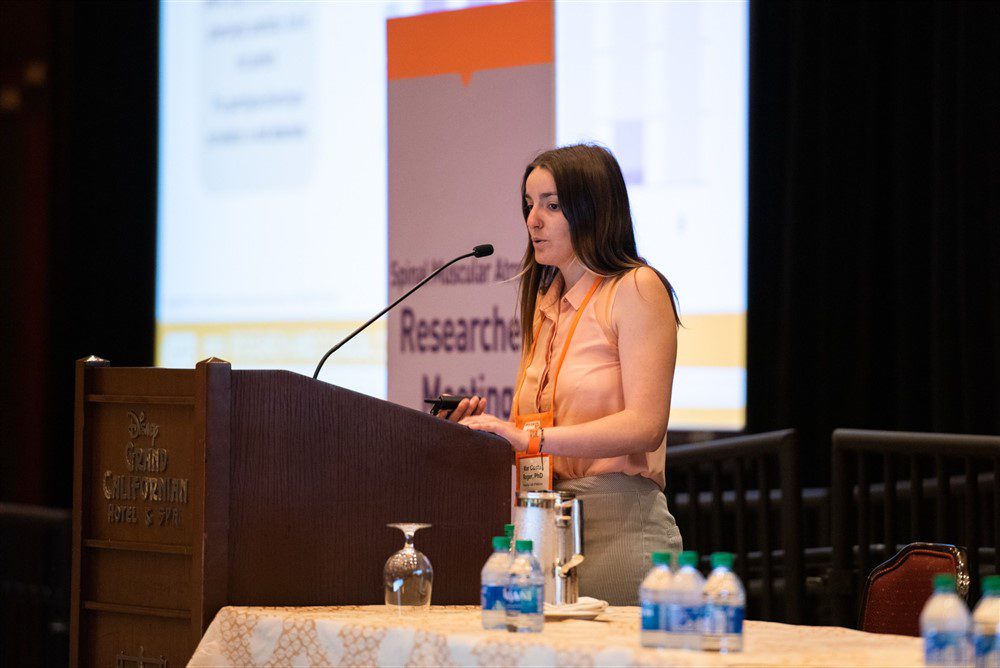In June, SMA researchers and clinicians from around the world met in Anaheim, CA, for the 2022 Annual SMA Research and Clinical Care Meeting. There they shared their most recent data with the goal of accelerating the pace of research into SMA treatments and achieving excellence in SMA clinical care. Below is a summary of the podium presentations featuring some of the most important and exciting new advances in basic and clinical SMA research.

Basic Research Session 1
Dr. Arthur Burghes moderated Basic Research Session 1. The four presentations in Session 1 described SMA research that focused on DNA, the chemical that encodes genes, or RNA, the chemical that has multiple roles in the translation of genes into proteins. Dr. Arlene D’Silva gave the first presentation, which described the differential expression of microRNAs (miRNAs) in the spinal fluid of SMA-affected children during nusinersen treatment. miRNAs are short RNAs that are not translated into proteins but help regulate gene expression. D’Silva and her colleagues found that the expression of several miRNAs that are involved in neuronal cell function and survival changed throughout treatment. Dr. D’Silva concluded that these miRNAs have the potential to help researchers and clinicians learn more about how SMA progresses and responds to treatment. Dr. Emanuela Abiusi gave the second presentation, in which she showed how her research group compared miRNAs expressed in the muscle cells of SMA-affected individuals and unaffected individuals. The researchers identified over 100 miRNAs that were differentially expressed in the muscles of individuals affected by SMA, and they proposed that this differential expression may be used in the future, alongside other factors like SMN2 copy number, in determining SMA prognosis.
The third presentation in this session was given by Dr. Mar Costa Roger. Dr. Roger’s research group analyzed the SMN2 genes of 11 individuals from around the world who are affected by SMA and carry a specific gene variant. The gene variant has been shown to result in a milder SMA phenotype. A deep characterization of the entire SMN region within these individuals indicates that all 11 variants likely share a single worldwide origin. This work points to the complex relationship between genotype, genetic makeup, and phenotype, observable characteristics of an individual, and the need for further work to understand how genotype impacts phenotype to improve prognostic outcomes. Emma Sutton, MPhil, gave the final Session 1 presentation, in which she described her groups’ work in a mouse model of SMA and muscle cells from individuals affected by SMA type III. Their work suggests that a compound, called mifepristone, may improve SMA-affected muscle function by regulating a protein that is aberrantly expressed in muscles cells. The group concluded that this pathway is a potential target for non-SMN dependent SMA therapy.
Basic Research Session 2
The four presentations in this session, which was moderated by Dr. Elliot Androphy, described various aspects of how ion channels, pores in the membranes of cells, regulate neuronal functionality. First, Dr. Nandhini Sivakumar presented data that suggests using a drug to modulate the expression and activity of a potassium channel may improve vulnerable motor neuron function in a mouse model of SMA. The subsequent three presentations were related to some aspect of the effects of calcium signaling in motor neuron pathology. Dr. Lucia Tabares reported on her laboratory’s findings that a drug called nifedipine can promote the transmission of information from the nerve to the muscle in SMA mice. Tamas Schmidt then showed data that supports the idea that overexpression of the protein Plastin3 reduces levels of a protein called STIM1, which may result in more efficient calcium entry into cells. Dr. Stephen Meriney wrapped up the session by showing how the small molecule GV-58 increased calcium channel opening at the motor nerve terminal and improved muscle strength in a mouse model of SMA.

Basic Research Session 3
The first two presentations made in Session 3, moderated by Dr. Umrao Monani, explored strategies for combinatorial approaches to treating SMA. In the first session, Dr. Maria Carlini described work to inhibit an enzyme, p38MAPK, for which inhibition has been previously shown to suppress cellular effects of low levels of SMN. Her group used a mouse model of SMA to show that inhibiting this enzyme after treatment with an SMN modulator could improve therapeutic outcomes. Next, Dr. Cynthia Bezier highlighted work suggesting that BIO101, a drug that activates a muscle receptor, may be useful for SMN-independent treatment of SMA. Bezier showed data indicating that muscle health and fatigue in SMA mice improved when treated with BIO101 alone or in combination with a drug that increases SMN expression.
In the remainder of the Session 3 presentations, the audience heard from scientists who were trying to better understand the cellular and molecular basis of SMA. Aofie Reilly described the different effects of restoring SMN to either the central nervous system (CNS) or the peripheral tissues of an SMA mouse model using a gene therapy vector. While both therapeutic strategies mitigated disease in terms of animal survival, only CNS administration of the SMN gene protected motor neurons. This study is ongoing to determine if long-term rescue for both treatment paradigms can be maintained. Dr. Anton Blatnik then presented data refuting the importance of interaction between SMN and the protein alpha-COP, previously implicated in the ability of SMN to conduct critical cellular functions. SMA mice treated with a viral vector containing the SMN gene lacking the domain essential for this interaction were partially rescued in terms of survival. Furthermore, motor unit number and function were restored.
In the fifth Session 3 presentation, Dr. Lyndsay Murray described how her group was able to use either SMN upregulating therapies to stimulate regeneration of motor units, an individual motor neuron and all the muscle fibers to which it connects, in an SMA mouse model. However, motor unit regeneration after each intervention was incomplete, indicating that supporting neuromuscular junction recovery following SMN upregulating treatment is important. The penultimate speaker of the session, Dr. Emily Welby, presented data demonstrating the importance of adequate SMN protein levels in astrocytes, cells in the central nervous system that support neurons. Dr. Welby provided evidence that astrocytes contribute to motor neuron dysfunction in SMA, specifically through the disruption of cell surface proteins. Ines Tapken was the final speaker in Session 3. She described an analysis of proteins gone awry in peripheral organs and the CNS of an SMA mouse model. This data has the potential to shed light on how low SMN protein levels cause the various disease manifestations associated with SMA.



